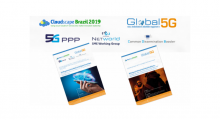
Market Drivers for Healthcare Innovations
According to the World Health Organization "Global Health Observatory (GHO) data" (2015), the average spending in the healthcare sector is around 10% of GDP worldwide, making it a $7,200 billion market. Data for 2015 spending in Europe is available on this dashboard. In 2017, Goldman Sachs Global Investment Research, $650 billion in savings can be expected by 2025 through a shift in focus from volume-based healthcare to value-based healthcare ("Healthcare’s Holy Grail: Better Outcomes at Lower Costs," February 2017).
In 2019, IDC and Trust-IT analysed the potential impacts of advances in connected-health technologies enabled by 5G, building on improvements in collaboration and communications tools as well as new care-delivery models. Evidence shows that a growing number of healthcare systems are reforming service provision through new business models inspired by the Value Based Health Care paradigm. Examples include making access to care more convenient, such as remote patient monitoring, virtual care, robotics, and telepresence. It is expected that 5G will render information available at a more accurate and granular level than before.
Current implementations are already showing the benefits that these solutions can deliver to patients and healthcare professionals. But as adoption grows, solutions will be challenged by the complex demands posed by the volume, variety, and velocity of health information on communication networks. To ensure the functioning of mission-critical applications and devices, more sophisticated connectivity capabilities will be required. 5G can help meet some of these challenges.
5G enablers for healthcare span: Faster speeds, lower latency, increased connection densiity, QoS guarantees specific to individual use cases. 5G can also be a key connectivity enabler for smarter healthcare scenarios that combine Internet of Medical Things (IoMT), robotics, artificial intelligence, and cloud computing. Together, these solutions can ensure the more effective use of high volumes of alerts and data that typically overwhelm healthcare provider capabilities by separating the noise from the signal.
Other benefits for healthcare organisations include: Aligning their connectivity infrastructure more closely with their specifc needs; redundant coverage and high system availability in different applications and devices across multiple network nodes; prioritisation of critical transmissions, such as the management of insights and traffic (e.g. actionable data, data that should be saved); enabling more meaningful engagement with the intelligent edge.
Click here for a downloadable high-level view of the main 5G application groups in the healthcare sector:
- Site Connectivity and Management: Using both 4G (LTE) and 5G to combine the capacity and reliability of wired enterprise networking technology (e.g., Ethernet) with the flexibility of wireless enterprise networking technology (e.g., WiFi).
- Emergency handling: Improving the ability of healthcare organisations to handle emergency situations leveraging 5G as a high-performance network with wide-area coverage. Considerable potential could come from broadening the scope of treatment at the scene and in transit to the hospital. In time-sensitive emergency care, 5G can play a critical role in ensuring that patients' vital signs are shared in real time for immediate diagnosis and treatment.
- Remote and Extended Practice: Increasing the range of locations and circumstances for remote collaboration and its scope. More efficient use of scare specialist expertise (Internet of Skills). Extended scope of remote collaboration from 5G URLLC and network slicing for medical procedures though remote surgery is still a long way away.
- Outpatient Treatment and Management: Applying digital technology to reduce the number of times patients need to travel to medical facilities and the number of times healthcare workers need to visit patients at home. Suppoting ubiquitous and seamless access to care services outside the hospital and surgery setting.
- Training and education: Enhancing the training and education of medical professionals though telepresence and remote equipment control. increasing the range of training activity that can be carried out without direct access to a patient, e.g. more realistic simulation activities, enabled by high-resolution VR and haptic feedback (widening access to medical equipment), can be carried out at a variety of locations and simultaneously at multiple sites.



